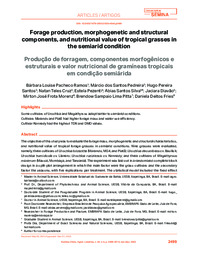Forage production, morphogenetic and structural components, and nutritional value of tropical grasses in the semiarid condition.
Forage production, morphogenetic and structural components, and nutritional value of tropical grasses in the semiarid condition.
Autoria: RAMOS, B. L. P.; PEDREIRA, M. dos S.; SANTOS, H. P. dos; CRUZ, N. T.; PEZENTI, E.; SILVA, A. S.; DIAVÃO, J.; MORENZ, M. J. F.; PITTA, B. S. L.; FRIES, D. D.
Resumo: The objective of this study was to evaluate the forage mass, morphogenetic and structural characteristics, and nutritional value of tropical forage grasses in semiarid conditions. Nine grasses were evaluated, namely, three cultivars of Urochloa brizantha (Marandu, MG4, and Piatã); Urochloa decumbens cv. Basilisk; Urochloa humidicola cv. Llanero; Urochloa ruziziensis cv. Kennedy; and three cultivars of Megathyrsus maximum (Massai, Mombaça, and Tanzania). The experiment was laid out in a randomized complete block design in a split-plot arrangement in which the main factor were the grass cultivars and the secondary factor the seasons, with five replications per treatment. The statistical model included the fixed effect of treatment (grass), whereas the season was included as a random effect within treatments. Urochloa brizantha cvs. Marandu, MG4, and Piatã and Urochloa decumbens cv. Basilisk produced on average 858 kg ha-1 more forage mass than cvs. Kennedy and Basilisk. Megathyrsus maximum cv. Mombaça produced 40% more forage mass than the other cultivars of M. maximum (4205 vs. 3001 kg ha-1). Urochloa ruziziensis cv. Kennedy showed the lowest water use efficiency (36%). Urochloa ruziziensis cv. Kennedy exhibited the lowest leaf weight among the Urochloa cultivars (740 vs. 1319 kg ha-1). There was no treatment effect for leaf weight in the M. maximum cultivars. Urochloa ruziziensis cv. Kennedy showed the highest values of total digestible nutrients and dry matter digestibility (1.84 and 2.34%, respectively) among the other Urochloa cultivars. The M. maximum cultivars showed little differences in nutritional values. Cultivars Marandu, Piatã, and Massai exhibited better productive responses in the edaphoclimatic conditions of this study. However, future studies must be conducted evaluating the adaptation of the forage grass under semiarid conditions. Considering the settings of this study, the grasses Urochloa brizantha cvs. MG4, Marandu, and Piatã, as well as Megathyrsus maximum cvs. Massai and Mombaça, can be used in the semiarid condition.
Ano de publicação: 2022
Tipo de publicação: Artigo de periódico
Unidade: Embrapa Gado de Leite
Palavras-chave: Capim Urochloa, Estresse hídrico, Planta Forrageira, Produtividade
Observações
1 - Por padrão são exibidas publicações dos últimos 20 anos. Para encontrar publicações mais antigas, configure o filtro ano de publicação, colocando o ano a partir do qual você deseja encontrar publicações. O filtro está na coluna da esquerda na busca acima.
2 - Para ler algumas publicações da Embrapa (apenas as que estão em formato ePub), é necessário ter, no celular ou computador, um desses softwares gratuitos. Sistemas Android: Google Play Livros; IOS: iBooks; Windows e Linux: software Calibre.
Acesse outras publicações
Acesse a Base de Dados da Pesquisa Agropecuária (BDPA) para consultar o acervo completo das bibliotecas da Embrapa.

